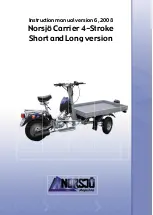
05-28
MMC2005-001_05A.FM
SECTION 05 - ENGINE PREPARATION
Flame speed is directly proportional to piston
speed in an almost linear fashion. Though it is not
completely understood why this relationship ex-
ists, it is thought to be related to intake speed and
mixture turbulence. Hence, flame speed increas-
es as RPM increases. It also increases as the air/
fuel ratio becomes leaner.
Because the flame speed is slower at lower RPM’s,
more advance at low RPM is necessary for maxi-
mum performance. Advancing the spark too much
BTDC for the needs of the engine will cause the
engine to go into detonation.
The optimum ignition would then have timing sig-
nificantly advanced at lower RPM, but would re-
tard the timing at higher RPM to keep the engine
out of detonation. Generally, as the ignition timing
is advanced, the low end mid range power will be
improved and the peak power will be moved to a
lower RPM. Retarding the timing will generally re-
duce low and mid range power but may allow jet-
ting to be leaner and increase peak power. Peak
power will be moved to a higher RPM. These are
generalizations and ignition timing must be opti-
mized depending on engine design, RPM range
and operating conditions.
Ignition advance on Rotax engines is measured by
a linear distance of piston travel BTDC. A dimen-
sion taken through a straight spark plug hole in the
center of the head is a direct measurement. A di-
mension through an angled plug hole on one side
of the head is an indirect measurement. A direct
measurement can be converted to degrees of
crankshaft rotation by the appropriate formulas.
Initial ignition timing procedures can be found in
the
Shop Manual
for the particular model being
worked on.
Ignition Timing
Ignition timing is no longer able to be adjusted me-
chanically. It must be done by your dealer with an
MPEM programmer.
Spark Plug Heat Range
Spark plug heat ranges are selected by measuring
actual combustion chamber temperatures. A cold-
er spark plug, one that dissipates heat more rapid-
ly, is often required when engines are modified to
produce more horsepower.
The proper operating temperature or heat range of
the spark plugs is determined by the spark plugs
ability to dissipate the heat generated by combus-
tion.
The longer the heat path between the electrode
tip to the plug shell, the higher the spark plug op-
erating temperature will be — and inversely, the
shorter the heat path, the lower the operating tem-
perature will be.
1. Cold
2. Hot
A cold type plug has a relatively short insulator
nose and transfers heat very rapidly into the cylin-
der head.
Such a plug is used in heavy duty or continuous
high speed operation to avoid overheating.
The hot type plug has a longer insulator nose and
transfers heat more slowly away from its firing
end. It runs hotter and burns off combustion de-
posits which might tend to foul the plug during
prolonged idle or low speed operation.
Generally speaking, if you have increased horse-
power by 10-15%, you will have to change to the
next colder heat range spark plug.
Most Ski-Doo’s are equipped stock with NGK BR-
9ES spark plugs.These are resistor-type plugs
which help reduce radio frequency interference.
To help prevent spark plug fouling use BR9ECS
type plug. Used
ONLY
resister type plugs.
A00E09A
1
2
Summary of Contents for ski-doo MACH Z 1000 SDI
Page 1: ...Mmc 2005 001 Racing FH8 Wed Sep 15 15 27 01 2004 Page 1 C M Y CM MY CY CMY K...
Page 118: ...04 36 MMC2005 001_04A FM SECTION 04 SUSPENSION SC 3 SC 4 RAS SC IV REAR SUSPENSION 0...
Page 124: ...04 42 MMC2005 001_04A FM SECTION 04 SUSPENSION SC 3 SC 4 RAS...
Page 476: ...MMC2005 001_13A FM 13 1 SECTION 13 ACCESSORIES TABLE OF CONTENTS 0 ACCESSORIES 13 02...
Page 493: ...Mmc 2005 001 Racing FH8 Wed Sep 15 15 27 01 2004 Page 1 C M Y CM MY CY CMY K...
















































